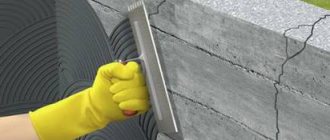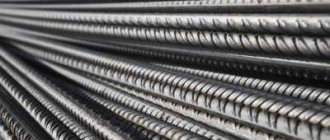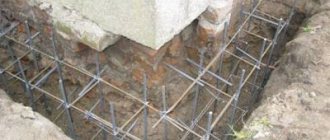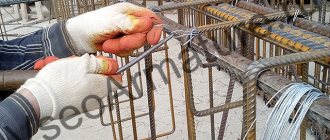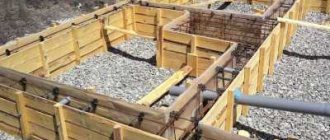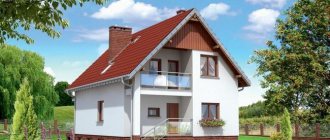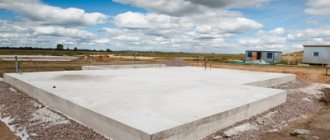Waterproofing a strip foundation is a very important and responsible stage in the construction of a building, the correctness and quality of its implementation will largely determine the strength, reliability, comfort and service life. Strip foundations are popular today due to their simplicity of design, durability, performance, and functionality.
The strip structure can be installed on almost any type of soil, offers a choice of several design options, and allows the use of various building materials.
But the main problem of this type of foundation is contact with the soil along the entire perimeter of the ground, which provokes the risk of concrete getting wet and the negative impact of moisture on the entire building. In order to avoid such problems, waterproofing measures are carried out both before and after the construction of the foundation.
Do I need to waterproof a strip foundation?
All types of strip foundations used in construction today consist entirely or partially of concrete. Concrete has a porous structure, which is why the material actively absorbs water.
When the temperature drops and reaches minus, water freezes in the pores of the monolith and destroys it from the inside, causing the appearance of cracks, delaminations, chips, complete deformation and destruction.
Waterproofing a strip foundation in the ground makes it possible to protect the monolith from moisture and water. In this case, it is possible to significantly increase the lifespan and improve the quality of operation of the building, eliminate the possibility of mold and mildew appearing indoors, avoid shrinkage, the spread of cracks and deformations in the base structure, and corrosion of metal elements.
Measures to waterproof the foundation must be carried out without fail, regardless of the level of groundwater, the type of soil, the structural features of the foundation itself, and the materials used in its construction.
But the choice of a specific waterproofing material and protection technology is carried out in accordance with many factors.
General requirements
According to the requirements of SNiP 3.04.01-87, before starting waterproofing work, the surface of the LF must be prepared :
- Seal the cracks.
- Cut down concrete overhangs.
- Eliminate corrosive processes.
- Round the corners.
- Dry the surface.
- Clean off dirt and dust.
When working with coating (painting) waterproofing compounds, you should be guided by the requirements of GOST 12.3.009-76:
the moisture level of concrete should not be higher than 4%;- Waterproofing is applied after the primer has dried;
- apply waterproofing in 2-4 layers, waiting for the previous layer to dry;
- the thickness of the applied waterproofing should be 3-6 mm;
- The waterproofing joints must overlap.
Building codes require the installation of waterproofing protection for the foundation on heaving or subsidence soils, with a high content of alkali or acids or animal products in the soil. However, practice has shown that water protection will never be superfluous.
In accordance with SNiP, waterproofing work is carried out at positive temperatures , avoiding exposure to strong UV radiation, rain and wind.
Differences between shallow and normal foundations
There are practically no fundamental differences in the installation of insulation for these types of foundations. The only differences are the area of treatment with the compositions, the volumes of materials, and the duration of all work. A shallow strip foundation differs from a conventional one only in the depth of immersion, but the same technology for carrying out the work is used.
Here it is worth remembering that the difference in the depth of immersion of a concrete structure means a noticeable difference in the density of contacts of the monolith and moisture from the soil. The usual type of strip base is lowered to a depth below the soil freezing line. The foundation is located in more difficult conditions and is affected by changes in water levels, periodic influx of melt moisture, and rain.
Therefore, in this case, waterproofing work is carried out using higher quality materials and sophisticated technologies in comparison with the treatment of shallow structures.
Installation stages of roofing felt
This process involves creating a single, seamless, impermeable layer that reliably protects the base. Horizontal waterproofing of the foundation with roofing felt occurs in the following way:
- the foundation walls are marked and demarcated in advance;
- make a screed from cement mortar;
- cover the hardened composition with a layer of bitumen mastic;
- each sheet of roofing material is coated with mastic and glued to the foundation so that the material completely covers the surface of the base and its sides;
- The roofing material is carefully leveled, using wooden graters so that the adhesive layer, that is, mastic, is evenly distributed over the entire area of the insulator and eliminates the formation of voids.
Insulating the foundation with rolled materials prevents liquid penetration into the basement floor and prevents load-bearing walls from coming into contact with the base plane.
Waterproofing methods
There are two main ways to waterproof a strip foundation - horizontal and vertical methods, each of which is carried out using a specific technology, using certain materials.
Horizontal
It is necessary to think about how to waterproof a horizontal strip foundation at the design stage of the structure. Preparatory activities can take up to 17 days (in addition to the main work). Horizontal insulation protects the foundation from capillary groundwater in the corresponding plane. It must include a drainage system, equipped when groundwater occurs at a high level.
A solid base is made under the tape, and a layer of waterproofing is mounted on it. Often, for this purpose, a cushion is created that is thicker than the future foundation. The simplest option (suitable for a bathhouse, garage, etc.) is to make a screed of cement and sand in a 1:2 ratio.
Technology for arranging horizontal waterproofing:
- Filling the bottom of the pit with sand in a layer up to 30 centimeters thick, tamping.
- Fill the cushion with a cement screed in a layer of 6-8 centimeters, harden for 2 weeks.
- Covering the screed with bitumen mastic, installing roofing felt sheets on top of the bitumen layer, repeating layers of mastic + roofing felt. Cement screed is poured on top in a layer of 6-8 centimeters and hardens.
- Construction of the foundation.
In some cases, drainage may be necessary: if the depth of the structure is below or at the level of groundwater, when the permeability of the soil is low and moisture can accumulate in it.
Performing drainage:
- 100 centimeters from the base, along the perimeter of the structure, a pit is dug up to 30 centimeters wide and 25 centimeters deeper than the depth of pouring the foundation. The pit should have a slope towards the drainage basin, where water will accumulate.
- Covering the bottom with a layer of geotextile, overlapping it with the walls by at least 60 centimeters.
- A layer of gravel 5 centimeters thick is laid.
- Installation of a drainage pipe with a slope to the catchment area of about 5mm/1 linear meter.
- Filling the pipe with a 25 centimeter layer of gravel, wrapping the sandwich with the geotextile edges left earlier, backfilling.
Such measures allow water to enter the pipe, eliminating the possibility of it clogging. Moisture will flow freely into the reservoir.
Vertical
This type of waterproofing of a strip foundation involves treating ready-made foundation walls with different materials. Work can be performed both during the construction of the building and after its completion. In addition, vertical insulation from water can be primary (when special hydrophobic additives are used in the construction of the structure to increase the resistance of concrete to moisture) or secondary (if the first type of insulation was not performed).
Depending on the installation site, vertical waterproofing can be external or internal. To accomplish the task, plastering and coating compounds, paint and varnish coatings, various sealing impregnations, lining materials, antiseptics, biocides, etc. are used.
The need for vertical waterproofing:
- When the foundation is affected by moisture from the soil, which is retained in the soil by adhesive or capillary forces and remains there permanently, regardless of the levels of groundwater and filtration water.
- If melt and rain water fills the pores in the soil and gets deep into the ground, seeping into the depth of the foundation.
- When the surface layer of underground moisture lies close.
Usually, not only the underground part of the foundation is isolated, but also the above-ground part, in order to exclude the influence of water rising up through the capillaries.
Which method is most optimal?
Experienced craftsmen, answering the question of whether it is necessary to waterproof a strip foundation, claim that both types are necessary and desirable.
Both horizontal and vertical protection are required
- only in this case can one guarantee a long service life of the building and the absence of any structural damage.
Features of the bitumen-polymer membrane
IKOPAL ULTRANAP is used for waterproofing underground and buried structures for various purposes, external insulation of wells, hydraulic structures, storm drains, foundations, including shallow strip foundations, etc. It protects the structure at different depths of groundwater and prevents the penetration of capillary moisture. Can be successfully used in combination with coating waterproofing.
Material structure
The anti-adhesive polyethylene film is removed immediately before installation. |
The bitumen-polymer membrane IKOPAL ULTRANAP is suitable for use in all climatic zones of Russia. The service life exceeds 30 years.
| The value of the indicator according to specifications | |
| Width, mm | 1000 |
| Length, m | 10 |
| Weight 1 m², kg | 5 |
| Tensile tensile strength, N, not less | 900 (11301) |
| Heat resistance for 2 hours, at temperature, °C, not less | 110 |
| Flexibility on a beam with a rounded radius of 25 mm at a temperature of °C, not higher | -30 |
| Binder brittleness temperature according to Fraas, °C, not higher | -40 |
| Water resistance at pressure: – 0.2 MPa for 24 hours; – 0.5 MPa for 6 hours | no signs of water penetration |
| Water absorption by mass, no more | 1 (0,03*) |
We invite you to familiarize yourself with Installing a drain on the roof of a house
(*) - results of tests of materials in the branch of OJSC TsNIIS Research Center "Tunnels and Subways".
Insulation of pile-strip foundation
The work includes two stages: high-quality processing of all piles and coating with an insulating layer of tape. To protect supports, various methods and materials are used - bored piles can be poured into tubes made of a special waterproof material, and driven piles can be protected where possible. But modern supports are usually made by manufacturers from moisture-resistant concrete (with special additives), so they are not afraid of moisture.
For processing the tape, you can also choose different options - coating (bitumen, tar), roll (roofing material), spraying with a rubber-bitumen composition, using polyurethane foam, etc.
The material is selected in accordance with the relevance of its cost, requirements for the level of protection, structural features of the foundation and the ability to implement this or that technology.
In what cases is this type of waterproofing used?
This type of secondary waterproofing is used when the primary protection of concrete from corrosion, i.e., the selected design solutions and materials that are not susceptible to corrosion, is insufficient.
Secondary protection is used in several cases:
- When non-hydrophobic or water-repellent grades of cement are used in the foundation concrete, and it does not have additives that perform these functions, the concrete and its steel reinforcement must be protected from corrosion.
- When the concrete is not water-repellent, but water can enter, for example, during heavy rains, spring snowmelt, etc. In this case, waterproofing the foundation walls and a horizontal layer separating the walls from the foundation is sufficient.
- Whenever the foundation is in water or when underground or groundwater is less than 1 m below the base of the foundation. In this case, even with the high hydrophobic properties of concrete, some of the water will still be absorbed into the thickness of the foundation.
How to protect your foundation from moisture
When a strip foundation is protected, waterproofing must meet the same requirements as in any other case - prevent water from penetrating into the concrete and destroying it, resist seasonal temperature changes, and serve for a long time and with high quality.
Main types of waterproofing
There are only two types of work - horizontal insulation involves laying a layer at the construction stage of the structure and protects it from underground moisture, vertical waterproofing of base walls. A separate subtype is drainage, which is installed in the most difficult cases.
Depending on the type of material, waterproofing can be:
- Pasting
– roll materials are used (roofing felt, geotextiles, various types of films)
- Coating
– mastics are used with cold/hot bitumen, polymer substances
- Sprayable
– when a layer of liquid material is applied using a special sprayer
- Impregnating
– slabs and blocks are treated with compounds that can penetrate the pores of concrete and make them resistant to moisture
Some waterproofing methods can be implemented with your own hands at home, while others require the use of industrial equipment, special tools, knowledge, and skills.
Performing waterproofing during laying
In the process of laying a strip foundation, waterproofing is performed in several stages.
Sequence of work:
- Formation of a sand and gravel cushion at the bottom of the trench in a layer up to 30 centimeters thick, compaction, leveling.
- Laying a concrete screed in a layer of up to 8 centimeters, after 14 days treating the surface with molten bitumen or mastic based on it, installing a layer of roofing felt, again passing with bitumen and again with roofing felt. The top is again filled with concrete up to 8 centimeters thick.
- Carrying out further construction work in 14 days.
Waterproofing after foundation construction
When the tape is ready, you can waterproof the foundation using different materials. This can be done both during the creation of the foundation and after its completion. The simplest method is to completely treat the tape with one or two layers of molten bitumen or mastic based on it. Rolled materials and the spraying method of various compositions are also used.
Drainage
Drainage is carried out under conditions of high groundwater. In this case, waterproofing cannot cope with the protection, and to protect the base from water, they create a system of underground channels that drain excess moisture. Drainage is required on heaving soils.
Types of drainage:
- Annular
– mounted below the basement floor level, 5-8 meters from the walls of the structure in an open/solid circle format with the internal space insulated from water.
- Wall-mounted
– relevant for clay soils, it is installed outside the building at a distance from the walls that is equal to the width of the base structure. The depth of the laying is not greater than the depth of the foundation.
- Plast
– suitable for high groundwater levels when pipes are installed under the foundation.
The sequence of work is simple: first, they dig a ditch along the general perimeter of the base, form a cushion of large crushed stone or broken brick, lay drainage pipes on top, always at an angle, and cover everything with geotextiles. The water flows into wells specially designed for this purpose, then the water is removed from the site.
Blind area
To protect the foundation from rain and melt water, a blind area is installed that runs along the entire perimeter of the building. The blind area is a not very wide concrete strip, made at a slope to the outside walls of the building, equal to approximately 2-5 degrees.
To make a blind area, soil is selected around the building in a layer up to 50 centimeters deep and 30 centimeters wide than the roof overhang. A sand-crushed stone cushion is formed in the trench, followed by compaction and leveling. A layer of concrete screed of at least 5 centimeters is poured on top. If you plan to walk on the blind area, the width of the screed should be about 10 centimeters.
Clay castle
Water can flow to the foundation not only from high groundwater or wet soil. During heavy rainfall, water flowing down the walls erodes the soil along the foundation. A clay castle and blind area are designed to protect against this.
To form a clay castle around the perimeter of the foundation, you need to dig a ditch 0.5 m deep from the outside.
The bottom layer will be a gravel-sand cushion 5 cm thick.
Before laying the clay, it must be brought to a plastic state. About the same as tight plasticine.
For convenience, in order to maintain the thickness and density of the layer, balls the size of a fist are formed from clay. These balls are laid in 2 layers, bridging the gaps, and compacted.
For residential buildings, a clay castle as the only waterproofing is not sufficient.
What materials should be used
When the question arises about whether it is necessary to waterproof a strip foundation and how best to protect it, it is necessary to proceed from such factors as the structural features of the foundation itself and the entire building, the type of soil, operating conditions, etc. There are many materials on the market today and choosing the most relevant option is not difficult.
Materials for foundation waterproofing:
- Rolled (also known as adhesive) - produced in the format of films, membranes, bitumen sheets, mounted on a layer of mastic or by heating, placing on glue (already applied to the sheets).
- Coating materials - bitumen, cold mastics, various compositions for application in liquid form with subsequent hardening.
- Penetrating - sprayed or applied with a brush, absorbed into the concrete monolith, followed by crystallization and filling of its pores, which makes the concrete resistant to moisture.
- Injection - similar in action to penetrating ones, they are applied by drilling holes in concrete and subsequent distribution of the composition under pressure, due to which the monolith is impregnated and strengthened from the inside.
- Painting – liquid polyurethane foam and liquid rubber can be used, which completely harden after application and create a water-repellent elastic film. They don't last long, but are easy to apply.
Why is waterproofing of artificial stone - concrete necessary?
Corrosion protection of building structures is divided into two types - primary and secondary.
Primary is the correct design of structures in which aggressive factors are reduced, as well as the use of materials that are resistant to the environment of future use.
Secondary protection - if the primary protection is insufficient, surface or impregnation insulation is additionally introduced.
Corrosion is understood not only as the process of metal rusting with its destruction, but also as processes leading to the destruction of concrete as an artificial stone.
Main types of concrete corrosion:
- leaching - dissolution and subsequent leaching of its, although weakly, soluble components from artificial stone when fresh water penetrates through the pores of concrete;
- acid destruction - under the influence of salts, acids and alkalis of inorganic and organic origin, soluble salts are formed in concrete stone, which are later washed out, and the remaining reaction results have a loose, non-astringent consistency, which reduces the strength of the stone.
- salt destruction - salts from external mineralized water crystallize in the pores of concrete; after its evaporation, the growth of crystals causes microstresses due to an increase in their volume, which leads to microcracks, and then to the destruction of the stone.
Types of insulation
There are many types of waterproofing. At the selection stage, it is important to correctly determine the appropriate option and not skimp on the quality of materials.
Bitumen coating
This method is considered the fastest, cheapest, and most popular. The foundation walls are completely covered with bitumen-based mastic, which fills chips, microcracks, and pores, preventing moisture from penetrating into them.
Coating waterproofing based on bitumen can be one-component (a block of bitumen that is heated before application) or include several different additives (supplied in a container, after mixing a chemical reaction takes place and the mixture acquires a liquid consistency).
The composition is applied to the surface of the foundation with a brush; before starting work, the monolith is thoroughly dusted and cleaned of dirt with brushes. This type of waterproofing is relatively inexpensive, all work can be done independently, updating the layer (repairs are not expected, installation of roll waterproofing is possible from above) will be required after 5-7 years.
Roll waterproofing
Also not a very expensive option. The most popular method is laying roofing felt. There may also be sheets of isoelast, aquaizol, and other materials. They are relevant for waterproofing any type of foundation, roof, swimming pools, and other structures. They also protect concrete from strong groundwater pressure. Houses without a basement require vertical and horizontal waterproofing.
Types of rolled waterproofing materials:
- Floating - before application they are heated (use a torch), then glued to a concrete monolith and wait for it to harden.
- Pasting – mounted with a composition based on bitumen or other adhesive. There are materials already with a self-adhesive layer that are applied quickly and easily.
The main advantages of rolled materials are ease and simplicity of installation, long service life, excellent water-repellent characteristics, high level of mechanical strength, and reliability.
The technology is quite simple: first, prepare the surface (must be smooth, dry, clean), then apply a layer of bitumen (fused materials and self-adhesive films are immediately mounted on the base), glue the rolled material with an overlap of 15 centimeters at the joints, which are then soldered with a gas torch.
Waterproofing with plaster compounds
Plaster mixtures include moisture-resistant components. The mixture must be prepared according to the instructions, applied with a regular spatula to the foundation, previously lined with a special plastic mesh. The main advantages of this method: speed and ease of work, service life in the range of 10-15 years, low cost. But microcracks may appear in the plaster and its resistance to moisture is far from maximum.
Application of liquid rubber
The composition is applied to a necessarily pre-primed surface with a roller, brush or special sprayer. Supplied in ready-made format. Often, after opening the container, the composition is not stored for a long time - it must be used immediately. It lasts up to 50 years, work is carried out easily and simply, very high waterproofing properties are guaranteed.
Often, to complete the task it is necessary to use a special sprayer, which complicates the process, especially if you need to do everything yourself. The price of the compositions is quite high, so they are not very popular on the market today.
Penetrating waterproofing
The most expensive and effective method of waterproofing a strip (and any other) foundation. The penetrating mixture is prepared on the basis of cement, quartz sand and special additives. The process is similar to plastering walls; some compounds can be applied with a brush or sprayed. After the layer is completed, special crystals are created in the concrete monolith that strengthen the concrete and repel liquid.
The main advantages of the material: high quality protection, complete absence of seams, ease of application, versatility, safety for human health.
Screened waterproofing
The method is used quite rarely. The principle of installing protection is as follows: special mats that have the property of repelling water are attached to the surface of the foundation with a special mounting gun. Panels can also be attached, which are inserted into locks located at the edges. It is impossible to carry out such work on your own; the entire process is carried out by specialists, provided they have a license.
Horizontal waterproofing
This type of protection is designed to protect the foundation and building from the destructive effects of capillary moisture. A strip of material is laid on the surface of the concrete, protruding 15 centimeters beyond the edges of the walls. The tape can be laid independently without fastening and a base, or as a covering layer on a coating of mastic or other composition.
Spray insulation
Modern technology, which is used both to protect new structures and to restore old waterproofing coatings. The main advantages of the method: simplicity and high speed of implementation of the task, long service life, complete absence of seams in the layer, rapid hardening, safety for health and absence of toxic substances, resistance to ultraviolet radiation, elasticity.
The only disadvantage we can mention is the high cost of such protection, since the work will require the use of special equipment.
Group of penetrating waterproofing materials Penetron
Penetron is the name of a whole complex of waterproofing materials, the combined use of which allows one to obtain high estimates of the effectiveness of the work.
Penetron - a complex of waterproofing materials
To eliminate capillary penetration of moisture, wall and horizontal (including ceiling) surfaces of concrete structures must be treated with Penetron waterproofing solution.
The average consumption of the Penetron composition, when calculating the dry mixture and coating in two layers, will be 0.95 kg/m2. Increased consumption is possible on uneven substrates with significant surface defects.
Preparation of the Penetron mixture does not require special knowledge or equipment. It can easily be prepared at the construction site with your own hands.
Preparing the mixture for waterproofing
Preparation of the solution
Instructions for preparing a penetrating mixture for concrete:
- measure the required amount of mixture and the required amount of water, based on a ratio of 2:1;
- add water to the dry solution (not vice versa), and mix until the required consistency is obtained;
- the amount of the prepared mixture must correspond to 30 minutes of continuous work on applying the composition to the base of the foundation;
- control the plasticity and mobility of the finished mixture;
Stir the mixture
The solution should be applied to a damp, well-prepared surface. Then, using a brush or a mortar pump with a special nozzle, apply the first layer.
It is necessary to give time to the applied layer to set with the base, and repeat the procedure for applying the composition.
Apply the mixture to the base of the foundation
The following work on the construction of the foundation is allowed to be carried out no earlier than 3 days after the completion of work to protect the foundation.
Sequence of work
Regardless of which material is chosen, the work is performed according to the same principle.
Stages of waterproofing:
- Selection of material and method of its application
- Thorough surface preparation - drying, cleaning, leveling
- Applying a preparatory layer (not all methods require this) - coating with mastic, glue, concrete primer, etc.
- Installation of waterproofing material - spraying, gluing, spreading with a brush or roller, fastening in other ways
- Waiting for complete drying/hardening
- Applying a second layer (if the technology provides)
Advantages and disadvantages of different methods
The coating method of applying waterproofing has the following advantages:
- high uniformity of the layer because there are no joints;
- ease of application - with a brush, roller or spatula; for large volumes spraying is possible;
- low price of the material and its application, and much more. etc.
The disadvantages are:
- a dry surface is required; there will be no adhesion on wet concrete, i.e. the mastic will quickly peel off;
- low temperature and mechanical resistance - during frost or mechanical stress, cracks may appear, so reinforcement with polyester or fiberglass mesh is required.
There are still disadvantages, but they are not so terrible.
What to do if the house is built without waterproofing the foundation
Waterproofing work to protect the strip foundation must be carried out during the construction process. If the house has already been built, but there is no insulation from moisture, urgent measures need to be taken. In this case, they completely dig out the basement or house along the perimeter of the foundation, starting from the corners and going to the walls of the foundation (so as not to disturb the strength of the building).
Next, the walls are cleaned of dust and dirt, without the use of water. All pores, crevices, cracks, and recesses are cleared of soil and filled with cement mortar or a special adhesive composition. When the walls are dry, they need to be treated with bitumen-based mastic.
The roofing material is cut into pieces of the required size, attached using a gas burner overlapping the walls horizontally, then another layer of material is applied vertically. At the corners of the structure, the rolled material must be wrapped and overlaps formed. At the end, they make drainage, fill the soil back, compact it, and fill the blind area.
Waterproofing a strip foundation is a very important and responsible process that requires the use of high-quality materials and strict adherence to technology. At the foundation construction stage, it is advisable to take care of two types of protection from water - horizontal and vertical.
Depending on the chosen method, work can be done independently or with the assistance of specialists.
Soil freezing depth according to SNiP, m
| Loams and clays | Fine sand, sandy loam | Sand is coarse, gravelly | |
| Arkhangelsk | 1,56 | 1,90 | 2,04 |
| Vologda | 1,43 | 1,74 | 1,86 |
| Ekaterinburg | 1,57 | 1,91 | 2,04 |
| Kazan | 1,43 | 1,75 | 1,87 |
| Kursk | 1,06 | 1,29 | 1,38 |
| Moscow | 1,10 | 1,34 | 1,44 |
| Nizhny Novgorod | 1,45 | 1,76 | 1,89 |
| Novosibirsk | 1,83 | 2,23 | 2,39 |
| Eagle | 1,10 | 1,34 | 1,44 |
| Permian | 1,59 | 1,93 | 2,07 |
| Pskov | 0,97 | 1,18 | 1,27 |
| Rostov-on-Don | 0,66 | 0,80 | 0,86 |
| Ryazan | 1,36 | 1,65 | 1,77 |
| Samara | 1,54 | 1,88 | 2,01 |
| Saint Petersburg | 0,98 | 1,20 | 1,28 |
| Saratov | 1,19 | 1,44 | 1,55 |
| Surgut | 2,22 | 2,70 | 2,90 |
| Tyumen | 1,73 | 2,10 | 2,25 |
| Chelyabinsk | 1,73 | 2,11 | 2,26 |
| Yaroslavl | 1,43 | 1,74 | 1,86 |
Do you need waterproofing for a strip foundation? – An unequivocal answer: on the territory of Russia, without protection from water, the foundation collapses. A strip foundation without waterproofing will have an unreasonably short lifespan or will lead to the destruction of the building.
Before choosing the type of insulation, you need to determine the conditions affecting the foundation:
- Determine the groundwater level. This is the most important indicator that determines the type of waterproofing.
- Purpose of the building. For residential and warehouse buildings, the requirements for waterproofing are different.
- Threat of floods. Are there seasonal rains or water overflows?
- Soils. Some soils are poorly freed from water and swell during frosts, but when warming, on the contrary, they fall. This heaving leads to the destruction of the foundation.
Related documents:
- GOST 13580-85. REINFORCED CONCRETE PLATES FOR STRIP FOUNDATIONS. Technical conditions.
- GOST 13580-85 SNiP 2.02.01-83. FOUNDATIONS OF BUILDINGS AND STRUCTURES.
- SNiP 2.02.01-83
Moisture insulation of formwork
To answer the question whether waterproofing is needed for formwork or not, let’s consider its main functions. The design is designed to limit the space into which the concrete solution will be poured to form the foundation. In other words, the main function of formwork is to form a liquid solution, which, when hardened, forms the necessary geometric shape.
Waterproofing strip foundation formwork
To assemble the formwork, as a rule, wooden panels are used, which are hygroscopic. Because of this, structural elements may be deformed, which will lead to distortion of the geometric shapes of the poured concrete base. In this case, the answer to the above question becomes obvious: waterproofing for formwork is really necessary.
What types of insulators are used for finishing formwork? To protect wooden formwork elements the following can be used:
- bitumen solutions;
- hydrophobic impregnations;
- water-repellent varnishes;
- roll insulators.
When calculating the amount of waterproofing materials used, it is worth noting that for formwork processing, painting with bitumen will be the most cost-effective option.
